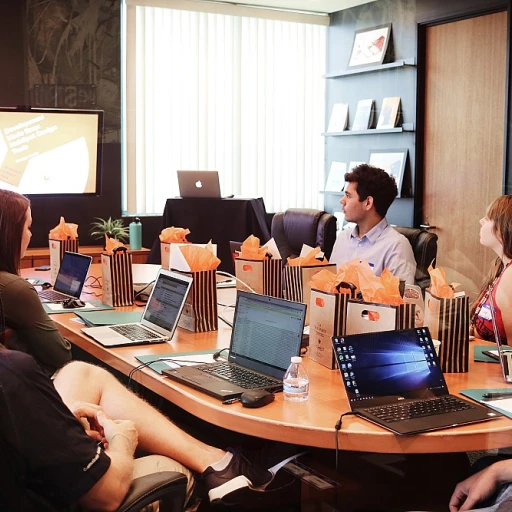
Understanding the Role of a Training Facilitator
In the realm of human resources, training facilitators play a crucial role in shaping the learning and development landscape. These professionals are responsible for guiding individuals and teams through educational programs designed to enhance specific skills, from soft skills to technical competencies. Their role is not merely about delivering content but fostering an environment where learning can thrive.
The Integral Role of Training Facilitators
Training facilitators are the linchpin in the delivery of effective training programs. They serve as both guides and encouragers, leading training sessions and workshops that promote knowledge transfer. Facilitators need to adapt to various roles, ensuring that each session is engaging for diverse groups of learners both in-person and online. They must be adept in navigating different learning environments, including virtual spaces that call for advanced facilitation techniques.
Moreover, the effectiveness of training facilitators is often measured by their ability to manage group dynamics and maintain participant engagement throughout the program. By leveraging facilitation skills, they can create a collaborative atmosphere that encourages active participation and peer learning. Effective facilitators also possess the unique ability to make complex subjects accessible, helping learners connect with the material in meaningful ways.
In the modern HR landscape, those who aspire to excel in this role must understand the impact of digital transformation. Facilitators need to embrace technology, using it to enhance the learning experience and reach a wider audience. Online courses and virtual training sessions are becoming more prevalent, demanding a new set of skills from those who lead them. Through continuous learning and professional development, facilitators can obtain certifications that validate their capabilities and ensure they remain at the forefront of training excellence.
Key Skills for Effective Training Facilitation
Core Competencies for Successful Training Facilitation
To become an effective training facilitator, it is imperative to develop a robust set of skills. These competencies ensure that training programs are engaging, informative, and produce the desired outcomes for learners. Here’s what’s crucial for mastering training facilitation:- Communication Skills: Excellent verbal and non-verbal communication is essential for facilitators to convey information clearly and engage participants effectively. Being able to listen actively and provide feedback adapts the learning process dynamically.
- Adaptability and Flexibility: Training sessions and learning environments can often be unpredictable. A skilled facilitator must adapt to varying group dynamics, unexpected questions, and technological challenges, especially in virtual settings.
- Group Management: Leading a group is an art that involves balancing participation, managing disruptions, and ensuring that all voices are heard. Strong facilitation skills in managing group dynamics are critical for maintaining a productive training atmosphere.
- Subject Matter Expertise: A profound understanding of the training topic enhances credibility and allows facilitators to provide insights that enrich the learning experience. While soft skills are paramount, subject matter knowledge cannot be underestimated.
- Facilitation Training and Certification: Pursuing facilitator certification programs reinforces the skills needed for success and demonstrates a commitment to professional development. An online course can also supplement face-to-face facilitator training, providing vital techniques and frameworks.
- Use of Technology: In today's digital age, facilitators benefit from leveraging technology to create interactive and effective online courses. Familiarity with various virtual training tools and platforms is essential for conducting seamless online sessions.
Designing Engaging Training Programs
Crafting Interactive and Impactful Learning Experiences
Designing engaging training programs is a critical skill for any effective facilitator. It's about creating a learning environment that captivates and motivates learners, ensuring that the content is not only informative but also memorable. To achieve this, facilitators must blend creativity with strategic planning, tailoring each session to meet the unique needs of their audience.
One of the first steps in designing an engaging program is understanding the roles and expectations of the training facilitator. This involves recognizing the diverse learning styles within a group and adapting the facilitation techniques accordingly. Whether the session is conducted in-person or as a virtual course, the facilitator must ensure that all participants are actively involved and engaged.
Incorporating Interactive Elements
Interactive elements are essential in maintaining the attention of learners and enhancing the learning experience. Activities such as group discussions, role-playing, and case studies can be integrated into training sessions to encourage participation and critical thinking. These methods not only make the sessions more dynamic but also help in reinforcing the subject matter.
For those looking to enhance their facilitation skills, exploring engaging activities for young people can provide valuable insights into creating more interactive and effective training programs.
Utilizing Technology for Enhanced Engagement
In today's digital age, leveraging technology is crucial in designing effective training programs. Online tools and platforms can facilitate interactive learning experiences, making it easier to conduct sessions that are both engaging and informative. Virtual breakout rooms, polls, and quizzes are just a few examples of how technology can be used to enhance participation and feedback.
Moreover, online courses and certification programs offer flexible learning opportunities, allowing facilitators to reach a broader audience. By incorporating these technological advancements, training facilitators can create programs that are not only effective but also accessible to a diverse group of learners.
Continuous Improvement and Feedback
Finally, an essential aspect of designing engaging training programs is the continuous improvement process. Gathering feedback from participants after each session can provide valuable insights into what works and what doesn't. This feedback loop allows facilitators to refine their approach, ensuring that each training program is more effective than the last.
In conclusion, designing engaging training programs requires a combination of creativity, strategic planning, and the effective use of technology. By focusing on these elements, training facilitators can create impactful learning experiences that drive development and growth among participants.
Overcoming Challenges in Training Facilitation
Addressing Common Obstacles in Training Facilitation
Training facilitators often encounter a variety of challenges that can hinder the effectiveness of their sessions. Understanding these obstacles and developing strategies to overcome them is crucial for any professional facilitator. Here, we explore some of the most common issues and how to tackle them effectively.
Engaging Diverse Learners
One of the primary challenges in training facilitation is engaging a diverse group of learners. Participants may come from different backgrounds, have varying levels of experience, and possess unique learning preferences. To address this, facilitators should employ a range of facilitation skills, including active listening and adaptability. Tailoring the training program to accommodate different learning styles can enhance engagement and ensure that all participants benefit from the session.
Managing Group Dynamics
Facilitators must also be adept at managing group dynamics. In any training session, there can be dominant personalities, quiet participants, and potential conflicts. An effective facilitator will create an inclusive learning environment where everyone feels comfortable contributing. Techniques such as setting clear ground rules, encouraging participation, and mediating conflicts can help maintain a positive atmosphere conducive to learning development.
Overcoming Technological Barriers
With the rise of virtual training programs, facilitators must be equipped to handle technological challenges. Issues such as connectivity problems, unfamiliarity with online platforms, and technical glitches can disrupt the flow of a session. Facilitators should be prepared with backup plans and ensure they are well-versed in the technology being used. Offering a brief tutorial on the platform at the beginning of an online course can also help participants feel more at ease.
Ensuring Content Relevance
Another challenge is ensuring that the training content remains relevant and engaging. Facilitators should work closely with subject matter experts to develop a curriculum that meets the needs of the learners and aligns with the goals of the organization. Regularly updating the content and incorporating feedback from previous sessions can help maintain the program's effectiveness.
Measuring Success and Impact
Finally, measuring the impact of training programs can be challenging but is essential for continuous improvement. Facilitators should establish clear objectives and use a variety of assessment tools to evaluate the effectiveness of their sessions. Gathering feedback from participants and analyzing performance data can provide valuable insights into the success of the training and areas for development.
Leveraging Technology in Training Facilitation
Enhancing Training Programs Through Technology
In today's digital age, leveraging technology in training facilitation has become essential to maximize the effectiveness of training programs. With an array of digital tools at their disposal, training facilitators can now create interactive and engaging learning environments that cater to the needs of diverse learners. One key aspect of incorporating technology is the use of online platforms and virtual classrooms, which allow trainers and facilitators to conduct sessions irrespective of geographical boundaries. This flexibility ensures that more learners can participate in the programs, thus broadening the base of knowledge sharing. Utilizing Technology for Interactive Learning- Online Courses: Facilitators can design comprehensive online courses that include interactive modules and multimedia content, enabling learners to grasp concepts effectively.
- Virtual Simulations: These provide a safe and controlled environment for learners to practice their newly acquired skills without the fear of real-world repercussions.
- Webinars and Video Conferences: Real-time communication tools foster collaboration and engagement within a group, allowing participants to learn from each other and the facilitator.













